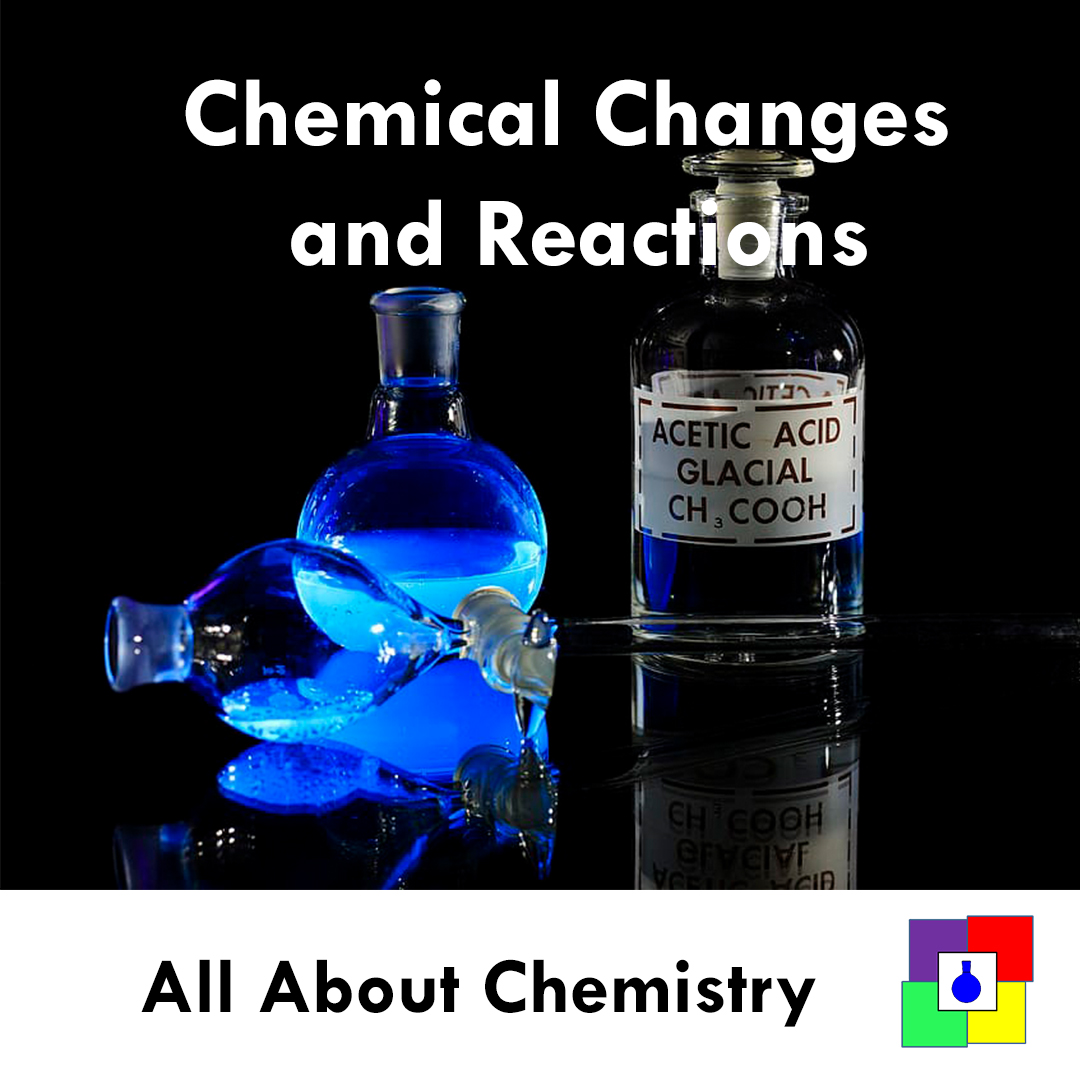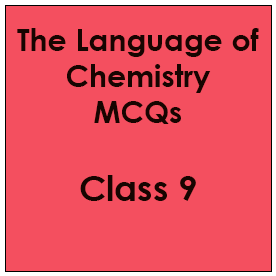Chemical Changes and Reactions
A chemical reaction can occur by two means-
- Reactant+ Reagent → Product
- Reactant + Reagent → Intermediate → Product
A reaction can take place only when –
- The molecules collide among themselves.
- The energy of the reactants should cross the threshold energy by absorbing activation energy.
- The molecules should orient themselves in a proper orientation.
Conditions necessary for a chemical change-
Mixing or close contact-
- P4 + 6I2 → 4PI3
- Pb(NO3)2 + 2KI → 2KNO3 + PbI2
In molten state or in aqueous solution:
- (COOH)2 + Na2CO3 → (COONa)2 + CO2 + H2O
- NaCl + AgNO3 → AgCl + NaNO3
- Any double decomposition reaction.
Heat:
- NH4NO3 → N2O + 2H2O
- NH4NO2 → N2 + 2H2O
- 4HNO3 → 2H2O + 4NO2 + O2
- 2NaNO3 → 2NaNO2 + O2
- 2Ca(NO3)2 → 2CaO + 4NO2 + O2
- 2Zn(NO3)2 → 2ZnO + 4NO2 + O2
- 2Pb(NO3)2 → 2PbO + 4NO2 + O2
- 2Cu(NO3)2 → 2CuO + 4NO2 + O2
- 2AgNO3 → 2Ag + 2NO2 + O2
- Hg(NO3)2 → Hg + 2NO2 + O2
- ZnCO3 → ZnO + CO2
- CuCO3 → CuO + CO2
Light :
- 2AgNO3 → 2Ag + 2NO2 + O2
- 2H2O2→2H2O + O2
- H2 + Cl2 → 2HCl
- 2Cl2 + 2H2O →4HCl + O2
- CH4 + Cl2 → CH3Cl + HCl
Electricity:
- 2NaCl → 2Na + Cl2
- PbBr2 → Pb + Br2
- 2H2O → 2H2 + O2
Pressure:
- N2 + 3H2 2NH3 200 atm
- HgCl2 + 2KI → HgI2 + 2KCl
- C6H5Cl + NaOH → C6H5ONa + HCl
Catalyst:
Chemical substances which can increase or decrease the speed of a reaction but itself remain intact in its mass.
Positive catalyst:
Chemical substances which can increase the speed of a reaction but itself remain intact in its mass.
| Preparation of | Reaction | Positive catalyst |
| Ammonia(NH3) [Haber’s process] | N2 + 3H2 2NH3 | Fe |
| Nitric Acid (HNO3 ) [Ostwald process] | 4NH3 + 5O2 →6H2O + 4NO | Pt |
| Sulphuric acid(H2SO4) [Contact process] | 2SO2 + O2 → 2SO3 | V2O5 |
| Ethane(C2H6) | C2H4 + H2 → C2H6 | Pt or Pd or Ni |
| Chlorobenzene(C6H5Cl) | C6H6 + Cl2 → C6H5Cl + HCl | Fe |
| Oxygen | 2KClO3 → 2KCl + 3O2 | MnO2 |
| Hydrogen (Bosch Process) | (CO + H2) + H2O → CO2 + 2H2 | Fe2O3 |
| Decomposition of hydrogen peroxide | 2H2O2 2H2O + O2 | Pt, Ag, Co, Fe, Cu, Au |
Negative catalyst:
Chemical substances which can decrease the speed of a reaction but itself remain intact in its mass.
| Reaction | Negative catalyst | |
| Decomposition of hydrogen peroxide | 2H2O2 2H2O + O2 | Glycerine, acetanilide, phosphoric acid, urea, alcohol |
| Oxidation of chloroform | CHCl3 + O2 → COCl2 | Alcohol |
Promoters:
Chemical substances that increase the efficiency of the catalyst.
- Mo or Al2O3 acts as a promoter of Fe during Haber’s Process.
- Chromic oxide acts as a promoter of Fe2O3 during the Bosch Process.
Catalyst Poison:
Chemical substances that can decrease the efficiency of the catalyst.
PbSO4+ S+ Quiniline acts as a poison during the preparation of acetaldehyde from Acetyl chloride.CH3COCl + H2 → CH3CHO + HCl
Characteristics of Chemical Reactions:
Evolution of gas:
- Zn + 2HCl → ZnCl2 + H2 ↑
- Na2CO3+ 2HCl → 2NaCl + H2O + CO2↑
- Na2SO3 + 2HCl → 2NaCl + H2O + SO2↑
- Na2S+ 2HCl → 2NaCl + H2S↑
- MnO2 + 4HCl → MnCl2 + Cl2↑ + 2H2O
- 2NH4Cl + Ca(OH)2 → CaCl2 + 2H2O + 2NH3↑
- Cu + 4HNO3 → Cu(NO3)2 + 2H2O + 2NO2 ↑
Change of colour:
- Fe + CuSO4(Blue solution) → FeSO4 (Green solution)+ Cu(reddish brown residue)
- Zn + CuSO4(Blue solution) → ZnSO4 (Colourless solution)+ Cu(reddish brown residue)
Formation of precipitation:
| Reaction | Colour of precipitation |
| Pb(NO3)2 + 2HCl → PbCl2 ↓+ 2HNO3 | White |
| Hg2(NO3)2 + 2HCl → Hg2Cl2 ↓ + 2HNO3 | White |
| AgNO3 + HCl → AgCl ↓ + HNO3 | White |
| BaCl2 + H2SO4 → BaSO4 ↓ + 2HCl | White |
| Pb(NO3)2 + H2SO4 → PbSO4 ↓ + 2HNO3 | White |
| CaCl2 + 2NaOH → Ca(OH)2 ↓+ 2NaCl | White |
| ZnCl2 + 2NaOH → Zn(OH)2 ↓+ 2NaCl | Gelatinous white |
| Pb(NO3)2 + 2NaOH → Pb(OH)2 ↓ + 2NaNO3 | Chalky white |
| FeSO4 + 2NaOH → Fe(OH)2 ↓+ Na2SO4 | Dirty green |
| FeCl3 + 3NaOH → Fe(OH)3 ↓+ 3NaCl | Reddish brown |
| CuSO4 + 2NaOH → Cu(OH)2↓ + Na2SO4 | Pale blue |
| CuSO4 + H2S→ CuS ↓+ H2SO4 | Black |
Change of state:
NH3 (g)+ HCl (g)→ NH4Cl(s)
Types of chemical reactions:
Synthesis or Direct combination:
Type of reaction where two or more substances combine to form a single product.
- NH3 + HCl → NH4Cl
- 2NO + O2 → 2NO2
- 2NH3 + H2SO4 → (NH4)2SO4
- 6NH3 + P2O5 + 3H2O → 2(NH4)3PO4
- N2 + 3H2 2NH3
- Pb + S → PbS
- Fe + S → FeS
- 2Fe + 3Cl2 → 2FeCl3
Decomposition:
The type of reaction where is compound is broken down into two or more elements or compounds.
Thermal decomposition:
The type of reaction where is compound is broken down into two or more elements or compounds by applying heat.
- NH4NO3 → N2O + 2H2O
- NH4NO2 → N2 + 2H2O
- 4HNO3 → 2H2O + 4NO2 + O2
- 2NaNO3 → 2NaNO2 + O2
- 2Ca(NO3)2 → 2CaO + 4NO2 + O2
- 2Zn(NO3)2 → 2ZnO + 4NO2 + O2
- 2Pb(NO3)2 → 2PbO + 4NO2 + O2
- 2Cu(NO3)2 → 2CuO + 4NO2 + O2
- 2AgNO3 → 2Ag + 2NO2 + O2
- Hg(NO3)2 → Hg + 2NO2 + O2
- ZnCO3 → ZnO + CO2
- CuCO3 → CuO + CO2
- MgCO3 → MgO + CO2
- 2Ag2CO3 → 4Ag + O2 + 2CO2
- (NH4)2Cr2O7→ Cr2O3 + 4H2O + N2
- Pb(OH)2 → PbO + H2O
- Zn(OH)2 → ZnO + H2O
- Ca(OH)2 → CaO + H2O
- Cu(OH)2 → CuO + H2O
- 4AgOH → 4Ag + O2 + 2H2O
Photochemical Decomposition:
The type of reaction where is compound is broken down into two or more elements or compounds by applying light.
- 2H2O2 → 2H2O + O2
- 2AgNO3 → 2Ag + 2NO2 + O2
Electrochemical Decomposition:
The type of reaction where is compound is broken down into two or more elements or compounds by passing electricity.
- 2NaCl → 2Na + Cl2
- PbBr2 → Pb + Br2
- 2H2O → 2H2 + O2
Displacement:
The type of chemical reaction where a more active element displaces a less active metal from its salt solution or aqueous solution.
- Zn + H2SO4 → ZnSO4 + H2
- Zn + CuSO4 → ZnSO4 + Cu
- Cl2 + 2KI → 2KCl + I2
- Fe + 2HCl → FeCl2 + H2
Double decomposition:
The type of reaction where the two compounds mutually exchange their radicals to form two new compounds in aqueous solution.
1.Precipitation Reaction:
The type of reaction where two compounds mutually share their radicals to form two compounds out of which one is an insoluble salt or precipitation in aqueous solution.
| Reaction | Colour of precipitation |
| Pb(NO3)2 + H2S → PbS ↓ + 2HNO3 | Black |
| 2AgNO3 + H2S →Ag2S ↓ + 2HNO3 | Black |
| ZnSO4+ H2S →ZnS ↓ + H2SO4 | White |
| Na2S2O3 + 2AgNO3 → Ag2S2O3↓+ 2NaNO3 | White → Yellow→Orange→Red→Brown→Black |
2. Neutralization Reaction:
The type of reaction where an acid reacts with a base to form salt and water only.
- NaOH + HCl →NaCl + H2O
- H2SO4 + 2NaOH →Na2SO4 + 2H2O
- HNO3 + NaOH →NaNO3 + H2O
3. Hydrolysis:
The type of reaction where a salt react with water to form an acidic or basic solution.
| Reaction | Nature of the final solution |
| Na2CO3 + 2H2O → 2NaOH + H2CO3 | Basic |
| CH3COONa + H2O → CH3COOH + NaOH | Basic |
| K3PO4 + 3H2O → H3PO4 + 3KOH | Basic |
| NH4Cl + H2O → HCl + NH4OH | Acidic |
| (NH4)2SO4 + 2H2O → H2SO4 + 2NH4OH | Acidic |
| CuSO4 + 2H2O → H2SO4 + Cu(OH)2 | Acidic |
| ZnSO4 + 2H2O → H2SO4 + Zn(OH)2 | Acidic |
| FeCl3 + 3H2O → 3HCl + Fe(OH)3 | Acidic |
| FeSO4 + 2H2O → H2SO4 + Fe(OH)2 | Acidic |
Exothermic Reaction:
The type of reaction where heat is produced.
- C + O2 → CO2
- CH4 + 2O2→CO2 + 2H2O
- CaO + H2O →Ca(OH)2
- N2 + 3H2 2NH3
Endothermic reaction:
The type of reaction where heat is absorbed.
- C + 2S → CS2
- N2 + O2 → 2NO
- NaNO2 + HCl → NaCl + HNO2
Reversible reaction:
The type of chemical reaction that can be reversed by changing the conditions of the reaction.
- 2SO2 + O2 2SO3
- N2 + 3H2 2NH3
- 3Fe + 4H2O + Fe3O4 + 4H2
Few Important Reactions:
| Reaction | Observation |
| 2Zn(NO3)2 → 2ZnO + 4NO2 + O2 | When zinc nitrate is heated, a residue is formed which is yellow when hot and white when cold. A reddish brown gas is evolved. |
| 2Pb(NO3)2 → 2PbO + 4NO2 + O2 | When lead nitrate is heated, a residue is formed which is yellow when hot and cold. A reddish brown gas is evolved. |
| 2Cu(NO3)2 → 2CuO + 4NO2 + O2 | When copper nitrate is heated, a black coloured residue is formed. A reddish brown gas is evolved. |
| ZnCO3 → ZnO + CO2 | When zinc carbonate is heated, a residue is formed which is yellow when hot and white when cold. A colourless gas is evolved which turns lime water milky. |
| (NH4)2Cr2O7 → Cr2O3 + 4H2O + N2 | When orange coloured ammonium dichromate is heated, green coloured residue is formed. |
| CuSO4.5H2O → CuSO4 + 5H2O | When blue vitriol is heated, a white anhydrous powdery solid is formed. |
| CuCO3 → CuO + CO2 | When copper carbonate is heated, a black coloured residue is formed. A colourless gas is evolved which turns lime water milky. |
Few important observations:
| Compound or element | Observation |
| H2 gas | Colourless odourless gas which burns with a pop sound |
| O2 gas | Colourless odourless gas which turns alkaline pyrogallol solution brown. |
| CO2 gas | Turns lime water milky but have no effect on acidified orange potassium dichromate solution green. |
| SO2 gas | i)Turns lime water milky ii)Turns acidified orange potassium dichromate solution green iii)Turns acidified pink potassium permanganate solution colourless. |
| H2S gas | i)Rotten egg smell ii)Turns moist lead acetate paper black iii)Turns lead nitrate solution black. |
| Cl2 gas | i)Greenish yellow gas ii) Turns moist starch iodide paper blue black |
| HCl gas | i)Produce a dense white fumes when comes in contact with a glass rod dipped in NH4OH. ii)A curdy white ppt is formed when the gas is passed through silver nitrate solution. |
| NH3 gas | i) Produce a dense white fumes when comes in contact with a glass rod dipped in conc.HCl. ii)Turns nessler’s reagent brown. |
| Water vapour | i) Turns anhydrous copper sulphate blue from white. ii) Turns anhydrous cobalt chloride pink from blue. |
| NO2 gas | i)Reddish brown gas ii)Turns acidified green ferrous sulphate solution brown. |









